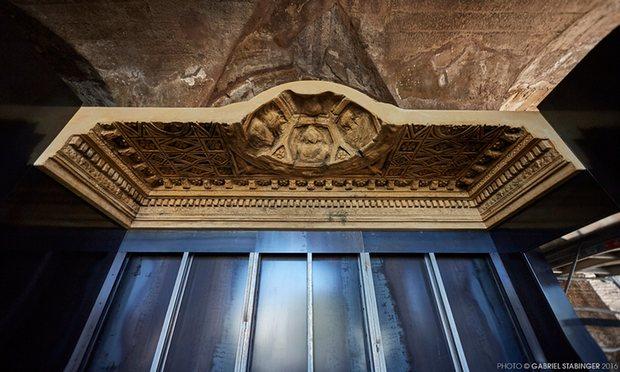A Palace Ceiling, a Winged Bull and a Room Full of History: 3D Printed Replicas of War-Destroyed Artifacts on Display at Roman Colosseum
 As ISIS rampages across the Middle East, precious works of art and architecture that have stood for thousands of years have been tragically mowed down in attempts to snuff out history, to destroy entire cultures. At the Colosseum in Rome, three 3D printed restorations stand as defiant evidence that cultural annihilation won’t be that easy.
As ISIS rampages across the Middle East, precious works of art and architecture that have stood for thousands of years have been tragically mowed down in attempts to snuff out history, to destroy entire cultures. At the Colosseum in Rome, three 3D printed restorations stand as defiant evidence that cultural annihilation won’t be that easy.
An exhibition entitled “Rising From the Ashes: Ebla, Nimrud, Palmyra” opened yesterday at the Colosseum and features 3D printed reproductions of three of the most notable architectural victims of recent war and terrorism: the Bull of Nimrud, a statue of a human-headed bull from the Northwest Palace in Nimrud, Iraq; the archive room of the Palace of Ebla in Syria; and part of a ceiling from the Temple of Bel in Palmyra, Syria.
The exhibit is designed to invite discussion of the possibilities technology offers for the replication and restoration of damaged or destroyed artifacts. 3D scanning and 3D printing are have been playing growing roles in archaeological restoration lately, particularly as historical sites are ravaged by war. “Rising from the Ashes” not only raises awareness of conflict-related cultural destruction but also shows how 3D technology can be used for preservation – in some cases, preemptive preservation.
Last year, the ancient Iraqi city of Nimrud was looted and destroyed with bulldozers and other vehicles. One of the artifacts lost was a giant statue of a winged bull with a human head, which stood as a guardian of a palace entrance. Thanks to a series of high-definition photographs, taken by members of the US military and stored in Mosul, however, a near-perfect reproduction of the statue could be created. Nicola Salvioli, a restorer based in Florence, was even able to replicate scratches on the surface of the statue.“We do not accept the return of iconoclasm, meaning the slaughter of heritage alongside the murder of innocent people,” Francesco Rutelli, exhibition curator and former culture minister and mayor of Rome, told the Guardian.
A great deal of care was taken to make sure the artifacts were reproduced in a scientific and respectful manner, said Rutelli, to ensure that they didn’t have a Caesar’s Palace kind of appearance. The bull statue and the other replicated artifacts were 3D printed with massive printers and then covered with a layer of plastic mixed with stone powder and finished by hand, bringing their appearance as close as possible to that of the original artifacts. The royal archive room of the Palace of Ebla, which contained over 17,000 ancient cuneiform tablets, was reconstructed by Arte Idea S.R.L., a company that specializes in film sets and scenery built with digital design techniques, while the ceiling of the Temple of Bel was recreated by 3D technology service bureau TryeCo.
The Temple of Bel, ravaged during the ISIS occupation of Palmyra, has been one of the most prominent examples of conflict-destroyed architecture being brought back with 3D technology. 3D printed replicas of the ancient temple’s archway are being erected in New York, Dubai and London, in what has been described as an act of solidarity with Syria as well as a demonstration of the capabilities of 3D technology.“There’s a lot of discussion over how to reconstruct what is lost,” Stefano De Caro, director general of the International Center for the Study of the Preservation and Restoration of Cultural Property, told the New York Times. “This is one proposal combining technical documentation and manual skill.”
The exhibit also displays two marble busts from the museum in Palmyra, heavily damaged during the occupation. “Rising from the Ashes” will be open through December 11, 2016. Discuss further over in the 3D Printed Architectural Replicas forum at 3DPB.com.
[Source: The Guardian / The New York Times]Subscribe to Our Email Newsletter
Stay up-to-date on all the latest news from the 3D printing industry and receive information and offers from third party vendors.
Print Services
Upload your 3D Models and get them printed quickly and efficiently.
You May Also Like
3D Printing News Briefs, October 18, 2025: Software Integration, Glass Bone Substitute, & More
In this weekend’s 3D Printing News Briefs, Velo3D and Dyndrite have announced an integration partnership. NCDMM announced the Director for the new Youngstown Innovation Hub for Aerospace and Defense, and...
3D Printing News Briefs, October 15, 2025: Thermal Simulation, Ceramic Fuel Cells, & More
In today’s 3D Printing News Briefs, Dyndrite and Ansys are collaborating on reducing risk in metal AM, and researchers from the Technical University of Denmark are 3D printing ceramic, coral-inspired...
The Photonic Chip 3D Printing Opportunity
Photonic chips may revolutionize a lot of processes and electronic devices, including 3D printing. Photonic chips, the development of the photonic integrated circuit, silicon photonics, light valves, integrated quantum photonics,...
3D Printing News Briefs, October 8, 2025: CSAM Research, 3D Printed Product Warning, & More
In today’s 3D Printing News Briefs, Florida International University acquired a WarpSPEE3D printer from SPEE3D for rapid production of large-scale metal parts. QuickParts announced an extension to its 3D printing...






































